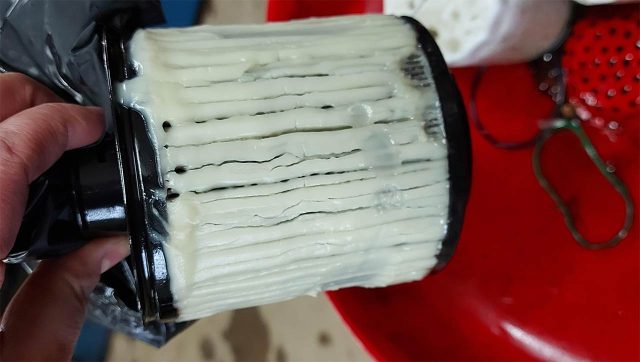%%date%% %%sep%% %%sitename%%
After a colder-than-normal night, you might find it difficult to start your diesel engine, or it might not start at all. This could be the result of gelled fuel. Here’s how to ungel it:
– The easiest way to ungel diesel fuel is to get the vehicle into a normal temperature zone. You can push it into a heated garage or simply wait for the temperature where your vehicle is parked to rise. The fuel will return to normal naturally.
– If you don’t have a heated space or the temperature is expected to remain low, then you’ll need to add a gel melting formula to your tank. Depending on your tank size and design, the time it takes to work can vary.
– The big problem is if you have gelled fuel in your lines or filter. You’ll need to remove your fuel filters and fill them with a de-gel formula and diesel fuel. Reinstall the filters and start the engine.
– In short, it’s better to prevent gelled fuel than it is to have to de-gel it as this isn’t a quick process.
Gelled diesel fuel. Source: Reddit
Why Does Diesel Fuel Gel?
Diesel fuel naturally contains wax, so when the temperature drops below a certain point, the fuel begins to gel. Gelling can occur at temperatures as high as 20 degrees Fahrenheit. Diesel fuel is made up of straight and branched-chain hydrocarbons, which are also known as paraffin waxes.
These compounds start to solidify around 17.5 degrees Fahrenheit for #2 diesel. The amount of paraffin wax in diesel fuel depends on the crude oil used to produce it and the manufacturing process. Biodiesel, which is a required diesel fuel additive in many states, starts to gel at higher temperatures than regular diesel.
How To Prevent Diesel Fuel From Gelling
As mentioned in the beginning, it’s better to prevent diesel fuel from gelling versus having to un-gel it in an emergency. One way to do this is to use a diesel fuel additive that’s designed to keep fuel from gelling down to temperatures as low as -40 degrees Fahrenheit.
For best results, you’ll need to add the anti-gel formula every time you fill up as long as the risk of low temperatures is an issue. Many fuel stations also sell winterized diesel fuel during the cold months. However, the ability of such winterized fuel to resist gelling varies widely. It’s generally better to be sure by adding your own anti-gel formula when you fill up.
Another preventative measure is to change your fuel filter every winter. Fuel filters hang onto contaminants that have been filtered out of your fuel. The more contaminants in the filter, the quicker it will cause fuel to gel. A clean fuel filter combined with an anti-gel additive should resist most gelling situations.
What Happens If Your Diesel Fuel Gels?
You’ll generally know if you have gelled fuel when your diesel engine won’t start or stops running in cold temperatures. In most cases, you won’t even be able to start it if the fuel is gelled. Gelled fuel won’t pump through fuel lines.
At this point, you can either push your vehicle into a heated garage or wait for temperatures to rise. The other solution is to use a de-gel formula. In this case, you’ll need to add it to the tank, but you’ll also need to remove the fuel filter and add de-gel and regular diesel fuel.
Sometimes you might have liquid fuel in your tank but your engine won’t start. As mentioned above, this can happen if you have a dirty fuel filter even if you’re dutifully adding anti-gel to your tank. To fix this, it’s best to remove the fuel filter and install a clean one. If you don’t have a clean one, you can add a mix of de-gel formula and regular diesel fuel, then reinstall.
FAQ On Gelled Diesel Fuel & Anti-Gel
Q: At what temperature does diesel gel?
A: For #2 diesel, which is the regular diesel used outside of winter climates, the gel point is usually around 15 degrees Fahrenheit, but it can potentially start gelling around 20 degrees or higher, especially if it’s mixed with biodiesel.
Winter blend diesel is also known as #1 diesel and it contains less paraffin. The gel point of the winter blend should be around -45 degrees Fahrenheit, but as mentioned above, this can vary widely depending on the quality of the blend.
Q: How long does it take for diesel to gel?
A: Gelling typically happens when the fuel is exposed to temperatures between 10 and 15 degrees Fahrenheit for 48 to 72 hours. If the fuel is of lower quality or mixed with biodiesel, the average temperature range can be higher.
Q: How much anti-gel should be used in each gallon of diesel?
A: The amount of anti-gel to use depends on the temperature and the specific formula you’re using. For example, Hot Shot’s Diesel Winter Anti-Gel recommends 4 ounces per 31 gallons in all temperature ranges.
Since most full size diesel pickup trucks hold between 26 and 36 gallons of fuel this works out to approximately 4 ounces per tank full. Be sure to check the instructions on the formula you purchase.
Q: When do you use diesel anti-gel?
A: Start using diesel anti-gel every time you fill up if temperatures are expected to drop below freezing for a prolonged period. It’s important to start using ant–gel before the temperatures drop below freezing to ensure it’s flowing through the entire fuel system. If you live in a place with cold winters, you should do this whenever you fill your tank.
You can count on ProSource Diesel for all your diesel engine needs, including parts, kits, fuel additives, and much more. We are where the diesel repair shops shop for diesel truck parts.
%%excerpt%%
The post How to Ungel Diesel Fuel appeared first on Prosource Diesel.
%%category%%
%%tag%%







